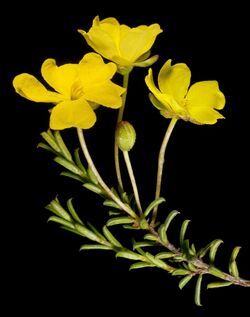Biology:Hibbertia lineata
| Hibbertia lineata | |
|---|---|

| |
| Scientific classification | |
| Kingdom: | Plantae |
| Clade: | Tracheophytes |
| Clade: | Angiosperms |
| Clade: | Eudicots |
| Order: | Dilleniales |
| Family: | Dilleniaceae |
| Genus: | Hibbertia |
| Species: | H. lineata
|
| Binomial name | |
| Hibbertia lineata Steud.[1]
| |
Hibbertia lineata is a species of flowering plant in the family Dilleniaceae and is endemic to the south-west of Western Australia. It is a spreading to erect shrub with linear to narrow egg-shaped leaves and yellow flowers, usually with ten stamens arranged on one side of, and leaning over the two densely hairy carpels.
Description
Hibbertia lineata is a spreading to erect shrub that typically grows to a height of 30–60 cm (12–24 in) and has its branches covered with star-shaped hairs when young. The leaves are linear to narrow egg-shaped, 5–15 mm (0.20–0.59 in) long and 0.6–1.0 mm (0.024–0.039 in) wide on a petiole 0.2–0.5 mm (0.0079–0.0197 in) long. The edges of the leaves are rolled under, obscuring most of the lower surface and the tip of the leaf often curves downwards. The flowers are arranged singly in upper leaf axils on a pedicel 5–20 mm (0.20–0.79 in) long with bracts 2–4 mm (0.079–0.157 in) long at the base of the sepals. The five sepals are joined at the base, egg-shaped and 5–6 mm (0.20–0.24 in) long, the inner sepals slightly wider than the inner sepals. The five petals are yellow, egg-shaped with the narrower end towards the base and 5.5–9 mm (0.22–0.35 in) long with a shallow notch at the tip. There are usually ten stamens, arranged in a single group on one side of, and leaning over the two densely softly-hairy carpels that each contain a two ovules.[2][3]
Taxonomy
Hibbertia lineata was first formally described in 1845 Ernst Gottlieb von Steudel in Johann Georg Christian Lehmann's Plantae Preissianae.[4][5] The specific epithet (lineata) means "marked with straight lines", referring to the leaves.[6]
Distribution and habitat
This hibbertia grows in kwongan and heath, mainly between Wagin and the Dragon Rocks Nature Reserve, but it is also widely in the Avon Wheatbelt Esperance Plains, Jarrah Forest and Mallee biogeographic regions in the south-west of Western Australia.[2][3]
Conservation status
Hibbertia lineata is classified as "not threatened" by the Western Australian Government Department of Parks and Wildlife.[3]
See also
References
- ↑ "Hibbertia lineata". Australian Plant Census. https://biodiversity.org.au/nsl/services/apc-format/display/71167.
- ↑ 2.0 2.1 Thiele, Kevin R. (2017). "A revision of the Hibbertia lineata (Dilleniaceae) species group". Nuytsia 28: 180–182. https://florabase.dpaw.wa.gov.au/science/nuytsia/815.pdf. Retrieved 11 July 2021.
- ↑ 3.0 3.1 3.2 "Hibbertia lineata". FloraBase. Western Australian Government Department of Parks and Wildlife. https://florabase.dpaw.wa.gov.au/browse/profile/5143.
- ↑ "Hibbertia lineata". APNI. https://id.biodiversity.org.au/instance/apni/482177.
- ↑ von Steudel, Ernst G. (1845). Plantae Preissianae. Hamburg. p. 272. https://www.biodiversitylibrary.org/item/199352#page/576/mode/1up. Retrieved 12 July 2021.
- ↑ Sharr, Francis Aubi; George, Alex (2019). Western Australian Plant Names and Their Meanings (3rd ed.). Kardinya, WA: Four Gables Press. p. 241. ISBN 9780958034180.
Wikidata ☰ Q17395341 entry
 |

